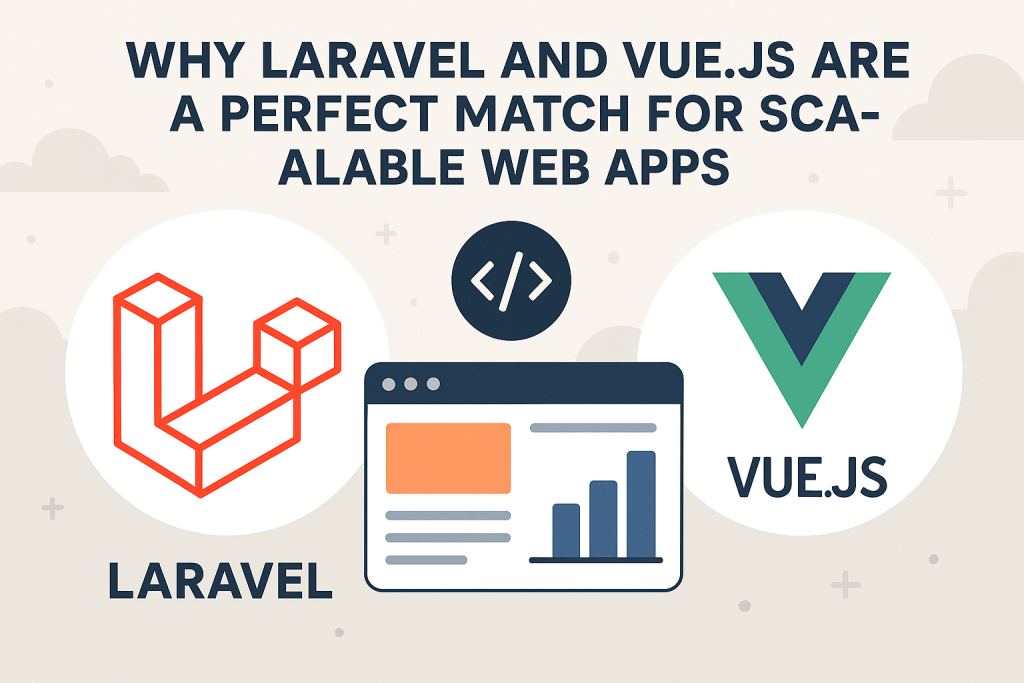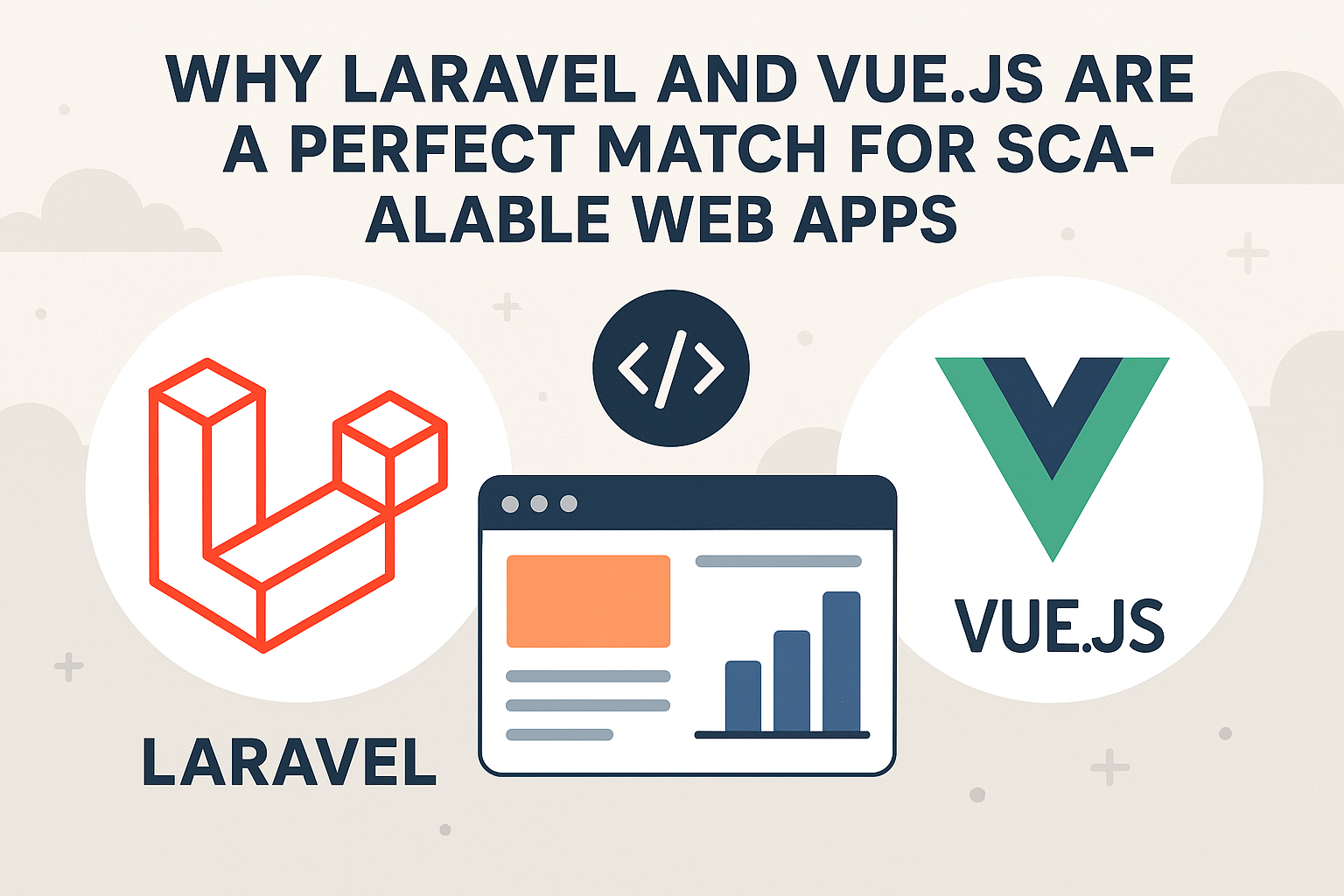
Introduction: The Growing Need for Scalable Web Applications
In today’s fast-paced digital landscape, scalability isn’t just a buzzword—it’s a necessity. Whether you’re launching a startup or managing an enterprise platform, your web application’s ability to grow alongside your business determines its long-term success. Choosing the right technology stack plays a crucial role in building apps that can evolve without breaking.
That’s where Laravel and Vue.js shine. This powerful backend-frontend combo has rapidly become a favorite for developers aiming to deliver rich, performant, and scalable applications.
Overview of Laravel and Vue.js
What is Laravel?
Laravel is a modern, open-source PHP framework designed to make web development elegant and efficient. It follows the Model-View-Controller (MVC) architecture and is known for its expressive syntax, powerful features, and developer-first mindset.
What is Vue.js?
Vue.js is a progressive JavaScript framework used for building interactive user interfaces. It’s lightweight, component-based, and incredibly flexible—ideal for anything from a simple widget to a full-scale single-page application (SPA).
The Strengths of Laravel for Backend Development
MVC Architecture and Routing Simplicity
Laravel’s adherence to MVC allows for clean code separation and structured development. Routing is intuitive, and developers can define routes in seconds using expressive syntax.
Built-in Authentication and Security Features
Security is baked into Laravel. It offers out-of-the-box solutions for authentication, CSRF protection, and password hashing—critical components for apps handling sensitive user data.
Laravel Ecosystem: Forge, Vapor, Nova, and More
From Laravel Forge (server management) to Laravel Vapor (serverless deployment), the Laravel ecosystem empowers developers to handle everything from hosting to advanced admin interfaces effortlessly.
Vue.js: A Lightweight Yet Powerful Frontend Framework
Component-Based Architecture
Vue encourages breaking down UIs into reusable, self-contained components. This modular approach streamlines development and simplifies debugging and testing.
Reactive Data Binding and Virtual DOM
Vue’s reactivity system automatically updates the DOM when your data changes, ensuring a seamless user experience. The virtual DOM optimizes rendering, making the frontend super responsive.
Integrating Vue with Laravel Blade Templates
Vue integrates naturally with Laravel’s Blade templates. You can sprinkle Vue components into existing pages or go full SPA, giving you flexibility based on project needs.
Seamless Integration of Laravel and Vue.js
API-Driven Development with Laravel and Vue
Using Laravel to build RESTful APIs and Vue to consume them is a winning strategy. It creates a clear boundary between frontend and backend, enhancing scalability and maintainability.
Laravel Mix for Asset Compilation
Laravel Mix offers a simple, fluent API for defining Webpack build steps for your Vue components, Sass, and JavaScript. It makes bundling and optimizing assets straightforward.
Shared State Management with Vuex and Laravel
Vuex helps manage shared state in larger apps, and when coupled with Laravel APIs, it enables a smooth data flow between client and server.
Why This Stack is Ideal for Scalable Applications
Performance Optimization and Load Handling
Laravel supports caching, database optimization, and job queues. Combined with Vue’s efficient rendering, the stack handles increased loads with ease.
Modularity and Code Maintainability
Both Laravel and Vue promote modular architecture. It’s easier to scale projects, onboard new team members, and manage growing codebases.
Real-time Features with Laravel Echo and Vue.js
Building real-time apps (like chat or notifications) is simple using Laravel Echo with Vue and libraries like Pusher or Socket.io.
Use Cases: Where Laravel + Vue.js Shine
SaaS Platforms
Laravel’s multi-tenancy and API capabilities, paired with Vue’s responsive UI, make it ideal for SaaS solutions.
Admin Dashboards and Analytics Tools
Vue’s component system and Laravel’s data processing power create powerful, interactive dashboards.
E-commerce Platforms and Marketplaces
With features like real-time inventory updates, payment integration, and custom UIs, this stack fits e-commerce perfectly.
Common Challenges and How to Overcome Them
Learning Curve for Beginners
Laravel and Vue both have deep ecosystems. Start small, use official docs, and consider learning platforms like Laracasts.
Handling State Across Components and Backend
Use Vuex for frontend state management and Laravel for session handling to keep data consistent.
Testing and Debugging Tools for Full-Stack Apps
Leverage Laravel’s PHPUnit and Vue’s Jest framework to ensure reliability through automated testing.
Best Practices for Building Scalable Apps with Laravel and Vue.js
Code Splitting and Lazy Loading
Reduce initial load times by splitting your Vue components and loading them on demand.
Using Queues and Background Jobs
Handle heavy tasks like emails or reports using Laravel’s built-in queue system.
API Rate Limiting and Caching Strategies
Implement throttling and use Laravel’s caching system to reduce server strain and increase speed.
Tools, Packages, and Resources to Supercharge Development
Laravel Sanctum, Passport, and Jetstream
Choose the right authentication method depending on your app—JWTs with Passport or simple tokens with Sanctum.
Vue CLI, Vue Router, and Composition API
Use Vue CLI to scaffold projects, Router for navigation, and Composition API for cleaner logic.
Monitoring Tools: Sentry, Laravel Telescope
Track bugs and performance issues with these powerful tools designed for modern full-stack apps.
Conclusion: The Future of Laravel and Vue.js in Web Development
Laravel and Vue.js offer an exceptional development experience, combining powerful backend capabilities with a smooth, dynamic frontend. Whether you’re building your first MVP or scaling a global platform, this stack provides the flexibility, scalability, and performance needed in modern web applications.
FAQs About Laravel and Vue.js
1. Is Laravel good for large-scale applications?
Yes. With features like caching, queues, and service containers, Laravel is highly suited for enterprise-level apps.
2. Can I use Vue.js without a full SPA setup?
Absolutely. Vue can be used for specific components inside Laravel Blade templates.
3. What’s better for frontend: Vue.js or React with Laravel?
Vue integrates more naturally with Laravel, especially for smaller or mid-sized teams, while React might be better for complex frontends.
4. How secure is Laravel for user data?
Laravel comes with built-in security features like CSRF protection, encryption, and authentication.
5. Does Laravel work well with other databases besides MySQL?
Yes, it supports PostgreSQL, SQLite, and SQL Server out of the box.
6. Can I deploy Laravel and Vue apps together?
Yes. They can be served together from the same project or separately using APIs.

